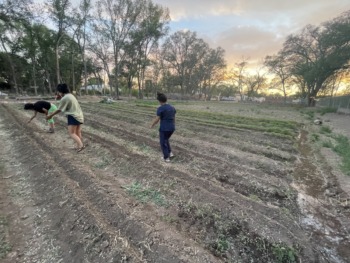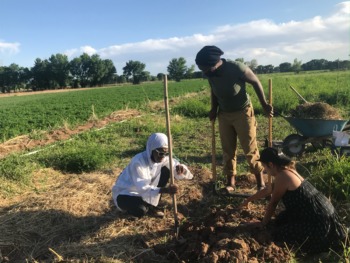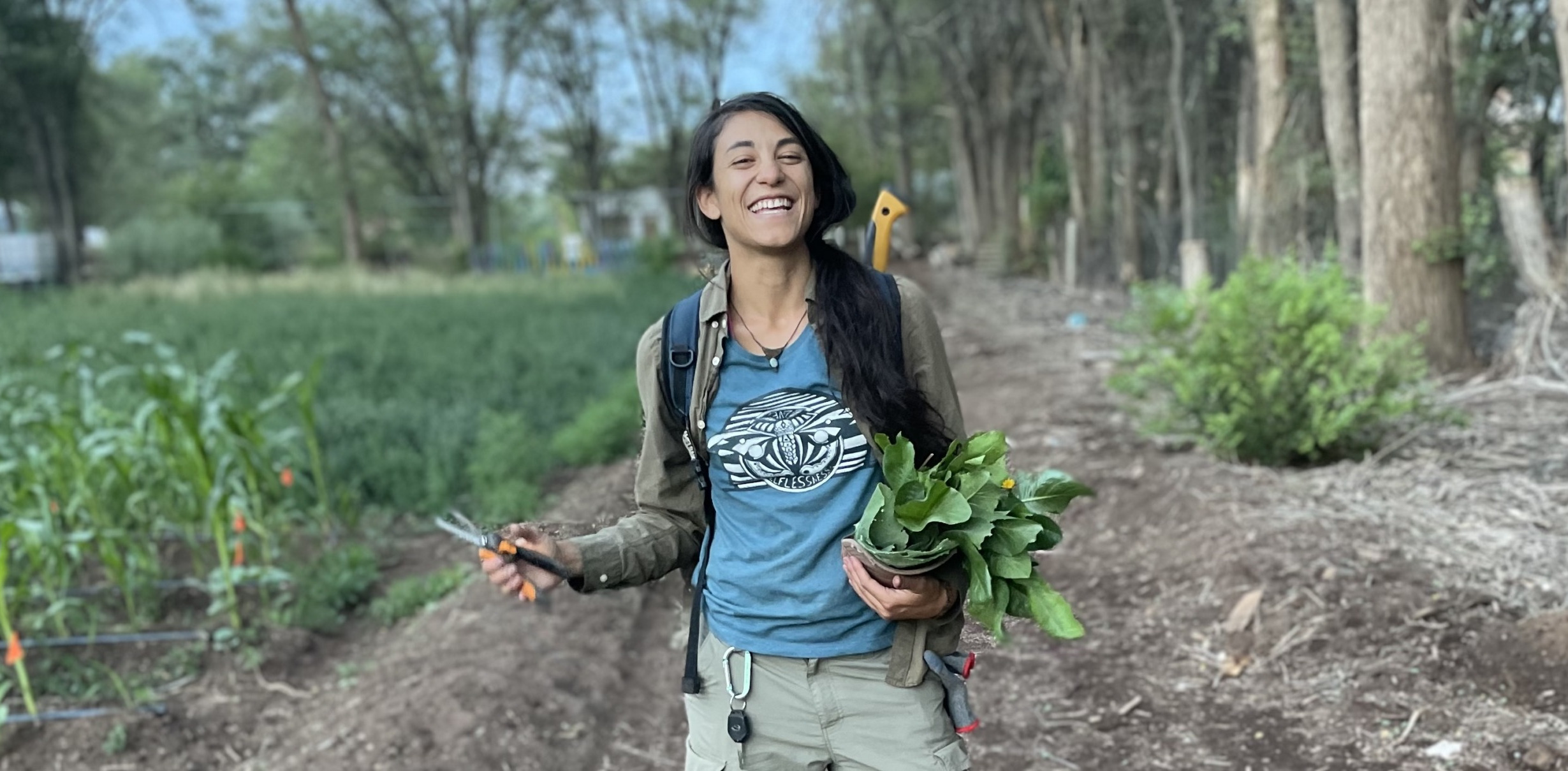Ana Moran knew things were bad long before the Rio Grande dried up in Albuquerque this summer for the first time in 40 years, but it was just one more sign that climate change was irrevocably changing the landscape of the western United States.
Two years ago, Moran, now 27, founded the women’s farming group Picaflor Collective, which grows vegetables like squash, beans and corn on two acres of farmland it leases in Albuquerque’s south valley.
The farm uses flood irrigation from the Rio Grande. Irrigation — a common practice of watering crops through small trenches that divert water from a larger source — had already been restricted to once per month when the river’s waters stopped flowing completely.

Courtesy of Ana Moran
Volunteers and members of Picaflor Collective tend to the farm in Albuquerque’s south valley.
For three months, Picaflor Collective hauled water in buckets and wheelbarrows from municipal water tanks hundreds of feet away, an expensive and exhausting endeavor in the Albuquerque heat.
“These are the costs we have to bear when there’s unpredictable water,” Moran said. “In the middle of a megadrought, you don’t know when you’ll have access to water and at what frequency.”
Young, small-scale farmers across the West, like those who sell produce at local farmer’s markets and run community gardens, are experiencing similar challenges as the region faces its worst drought in over 1,000 years. These growers are having to adapt farming practices and get creative to make their farms viable heading into a hotter, drier future.
Shifting climate, shifting methods, shifting crops
The western megadrought has changed the way farmers of all ages are looking at the future of farming. According to a survey from the American Farm Bureau Federation, nearly three-quarters of farmers said the drought damaged their harvest this year, with 37 percent of farmers killing off crops that wouldn’t survive due to dry conditions. The survey results came just as new water use restrictions on the Colorado River were announced for Arizona, Nevada, and Mexico in August.
Related Stories
• Campus divestment movement targets schools, nonprofit status
• ‘Every day was a bad day’: Children working in agriculture aren’t protected equally
• For youth activists, historic climate law is only the beginning
• Electrical workers union trains Chicago youth for growing solar market
• After a win for U.S. climate change education, classroom implementation is off to a slow start
• Youth find hope restoring Rio Grande wetlands threatened by climate change
• Youth and climate change: How a generation is adapting while fighting for their future
For Moran, who is working toward a dual graduate degree in community and regional planning and water resources at the University of New Mexico, adapting to the drought is a long game that starts with soil health.
This year, she and her colleagues left weeds in plant beds they weren’t using to help maintain soil moisture in the off-season and made sure to add sufficient mulch and manure to increase humidity.
The lack of water isn’t just about thirsty plants, though. Low levels of precipitation, coupled with hot temperatures, have also led to new pest problems.
Last year, Duke Jackson, a 28-year-old farmer and production manager for the farmer-in-training program at Fort Lewis College in Durango, Colorado, noticed an unsettling phenomenon happening in his community. Hordes of grasshoppers, which thrive in warm, dry weather, moved across farms eating nearly everything in their path.
The only crop that was safe from the grasshoppers was garlic, so Jackson and his fellow farmers decided to roll with it. They shifted their focus to growing garlic and launched the Grasshopper Collective, a farmer-run cooperative that sells garlic online.
“The Grasshopper Collective speaks to, more broadly, crop choice,” Jackson said. “The days of growing tons of lettuce and water-thirsty crops around the West are dwindling.”
Thinking outside the plot

Courtesy of Ana Moran
PicaFlor Collective uses regenerative farming practices and its members hope to expand into agriculture education.
Farmers like Jackson are adapting to the drought through altered farming practices, but the drought has also pushed young growers to diversify their businesses and expand into adjacent fields like agrotourism or growing technology.
Having multiple income streams and projects will be key for farms to build resilience to climate change, said Trelawney Bullis, a 28-year-old agricultural water engineer and water manager with Agricultural Capital Foods, an investment firm that funds farms using regenerative techniques.
She added that the rising cost of farmland — especially land with water — creates an even greater barrier for young growers to break into the industry. In a recent survey from the National Young Farmers Coalition, young growers said finding affordable land to buy was their top challenge in 2022.
“If you want to stay in farming as a young person, you’re gonna have to find a creative way to do that,” Bullis said. “By creating these co-ops or doing agricultural tourism, it makes it more feasible.”
This spirit of entrepreneurship was embraced by William Wimmer, 23, and his brother, Spencer Wimmer, 21, when they launched a mushroom farm in Tucson, Arizona in 2020.
While mushrooms aren’t immune to climate change, they can be drought tolerant and seemed like a good crop to invest in, William Wimmer said. Soon, they went from solely growing mushrooms to selling kits and other tools for those who want to grow their own.
“We pivoted the business to serve people who wanted to have their own food garden and to alleviate the stresses of food deserts,” William Wimmer said.
Moran is also looking to diversify in the future. Her collective co-manages the land at Del Cielo Farm, which aims to build a community for growers who have been historically disenfranchised, as well as to create a haven for local wildlife.
Moran hopes to tap into that community by turning Picaflor Collective into a nonprofit and hosting educational workshops for children and others to learn about drought-tolerant regenerative farming practices, water stewardship and ancestral foodways.
Meanwhile, in Albuquerque, a September monsoon brought rain, but it was only a temporary relief for the parched Rio Grande; dry ground struggles to absorb water, which in turn increases the risk of flash flooding.
Moran and her fellow growers have a new, grant-funded well on the property so they can more easily and freely access water. While other young farmers may have the vision and skill to adapt to the drought, Moran said, they’ll need similar support to ensure their place in the industry’s future.
“I see younger farmers as being on the frontlines of the climate crisis,” Moran said. “We’re shifting practices because we know that climate-smart changes are going to allow us to sustain our livelihoods and food security for generations to come.”
***
Maura Fox is a San Diego-based freelance journalist. She has written for outlets across Southern California reporting on local breaking news and U.S.-Mexico border issues. Fox is fluent in Spanish and holds a dual bachelor’s degree in English and in global studies from the University of California, Santa Barbara.






























